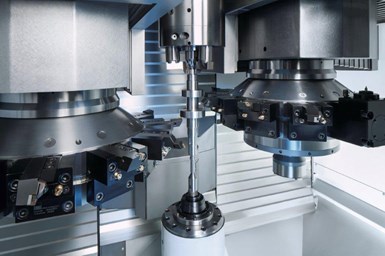Emag VT 4-Axes Lathes for Shaft Production Maximum Performance
Appears in Print as: '4-Axes Lathes for Shaft Production Maximum Performance'
IMTS 2022: The lathes are said to provide short cycle times, high-precision machining and safe processing with the VT series of turning machines literally turning the classic horizontal machining process on its head.
#horizontal-and-vertical-lathes #imts
Edited by Angela Osborne

The dual tool turrets of VT Series lathes, each with 11 stations (all of which can be equipped with turning tools along with driven tools), are said to guarantee flexibility. Photo Credit: EMAG
Manufacturing large quantities of shafts requires fast processes. Emag’s VT 2 and VT 4 lathes are said to provide not only precise and efficient machining, but their integrated loading and unloading systems also deliver optimum speed and performance. With short cycle times, high-precision machining and safe processing, the turning machines of the VT series are said to literally turn the classic horizontal machining process on its head.
In addition to employing four axes, short travels and a powerful main spindle, these modular lathes are twin-sided, enabling large batch components to be manufactured quickly. The dual tool turrets — each with 11 stations, all of which can be equipped with turning tools along with driven tools — are said to guarantee flexibility. Automation is fully integrated on these lathes. The turret loads and unloads work pieces into the machining area. While one gripper, occupying the twelfth position of the turret, conveys a new raw part into the machine, the other removes the finished component. The loading process can take as little as six seconds, depending on the workpiece.
The VT 2 can handle workpiece diameters up to 4" (100 mm) and lengths up to 15.5" (400 mm). The VT 4 accepts shafts up to 8" (200 mm) in diameter and up to 25" (630 mm) long.
Some advantages of the VT series include shorter cycle times through four-axes machining, less expense for automation and peripherals, and reduced idle times through cycle time-concurrent loading and unloading, the company says. The machine can be used as a stand-alone or in a production line. Easily accessible and operator-friendly workpiece areas mean short setting and resetting times. And less operator intervention because tailstock and steady are CN-controlled, and turrets can be accessed directly.
The company says the vertical construction of the machine and the resulting free chip flow prevent the creation of chip clusters. Raw part and finished component storage are said to form an integral part of the machine.
RELATED CONTENT
-
Get 5-Axis Machining on a 3-Axis VMC
Machine shops want and need to eliminate steps in the manufacturing process. Adding four- or five-axis capability to an existing three-axis VMC is a practical way to achieve five-sided machining using a single setup.
-
Selecting A VMC: Factors To Consider
A three-, four- or five-axis vertical machining center can run the gamut of capability and cost. Assessing your application requirements now and in the future can make for a much wiser machining center purchase.
-
Turning to an Adhesive for Lathe Workholding
Adhesive cured by ultraviolet light is an option for securing parts for machining that could otherwise distort when traditional, mechanical clamping techniques are used.
.png;maxWidth=970;quality=90)


